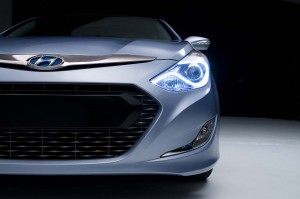
With its distinctive grille, the 2011 Hyundai Sonata Hybrid is expected to usher in a wave of new gas-electric models from the Korean carmaker.
Though its first hybrid model won’t reach U.S. showrooms for some months, Hyundai is already planning a big assault on the growing global market for gasoline-electric vehicles.
The 2011 Hyundai Sonata Hybrid will likely be followed by a mix of models, including dedicated hybrid offerings, much like the popular Toyota Prius, said senior Korean officials, with the technology expected to account for as much as 20% of the maker’s total global volume by the end of the decade.
But while plug-in models could be included in the mix, Hyundai is skeptical about the potential market for pure battery-electric vehicles, barring either significant improvements in battery technology or a significant shift in what consumers expect from their vehicles.
TheDetroitBureau.com paid a visit to Seoul to test the new Sonata Hybrid – a review of which we’ll post in the coming weeks — the first gasoline-electric model targeting the U.S., but the second in the Hyundai line-up, which saw a smaller HEV launch in Korean showrooms last year.
“We are spending a fortune on hybrid development,” said Hyun-Soon Lee, the automaker’s vice chairman.
The 2011 Sonata Hybrid is the only gas-electric model the maker will specifically confirm – for now – but Lee and other Hyundai officials don’t disguise plans to ramp up the hybrid line-up. One reason is the need to boost the brand’s overall fuel efficiency to meet the recently-increased Corporate Average Fuel Economy, or CAFE, standard. The Obama administration recently raised the numbers by about 30%, to 35.5 mpg by 2016. And Hyundai aims to meet that target at least a year early.
But observers anticipate yet another stiff increase in CAFE will be enacted for the latter part of the decade. And getting there is likely to require an increasing emphasis, everything from “micro-hybrids” to plug-in hybrids, said Woong-chul Yang, president of Hyundai’s R&D operation.
The emphasis will be on “expand(ing) our current system to other vehicles,” he said during a meeting at the Namgyang Proving Grounds. “We also have plans for dedicated (Prius-like) hybrids.” The Toyota model is the world’s best-selling hybrid-electric vehicle, and analysts suggest that is, in large part due to its distinctive shape which increases its appeal to motorists who want to be seen as going green.
Hyundai, suggested Yang, may bring to market a more sophisticated plug-in hybrid drivetrain that would allow motorists to operate in electric-only mode for more extended periods than the 2011 Sonata Hybrid.
The gas-electric Sonata will be the first commercial application of a lithium-polymer battery in a conventional hybrid. The technology, Hyundai officials stressed, is about a third smaller and lighter than the nickel-metal hydride technology used on Prius and the rest of today’s hybrid models, while increasing available power by about 15%.
Even so, he insisted that lithium batteries “still (are) not good enough for full battery vehicles” because they cost too much while delivering only about 100 miles range per charge. To make a battery-electric model truly competitive with gasoline power, he insisted, “We’d need seven times the level of performance at 20 times less price.”
Not everyone agrees, notably Nissan – which will bring its battery-electric vehicle, the Leaf sedan, to market late this year – and Ford, which will soon launch BEV versions of the Transit Connect van and Focus sedan.
Hyundai, officials said, would be more likely to follow General Motors’ approach with the Chevrolet Volt, which is to provide just enough battery range for the typical commuter but overcome so-called “range anxiety” by also outfitting the vehicle with a small backup gasoline engine.
Whichever way its model mix goes, Hyundai expects battery power to play a significant role in the coming decade.
“We expect around 20% of our total sales will be hybrids…globally…in 10 years,” said Vice Chairman Lee, who added that the main markets for the technology will likely be Europe, Japan, “and maybe China,” which is pushing its domestic makers to increase their own efforts to electrify.
